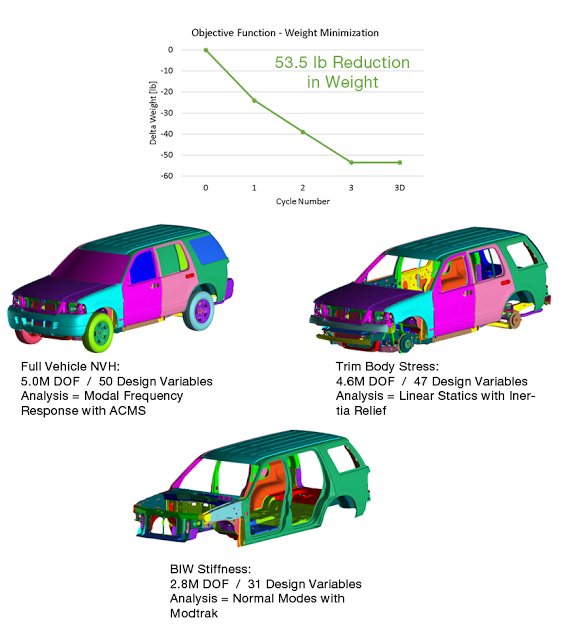Question: What are some of the optimization capabilities in MSC Nastran?
Answer: Just to name a few:
- Size
- Shape
- Topometry
- Topology
- Multi Model Optimization
Brief descriptions of each are given below.
SIZE
Use size optimization to improve the performance of designs by varying basic design parameters such as beam cross sectional dimensions, sheet thicknesses, composite ply orientations, material stiffness, material densities, and more. Achieve design objectives such as structural weight, displacements, stresses, etc.
 |
| Size Optimization – Fatigue Based – The graph depicts the variation of design variables (panel thicknesses) for each design cycle. |
SHAPE
Implement Shape Optimization to optimize the profile of designs. Specific boundaries may be selected and allowed to vary during the optimization process.
 |
| Shape Optimization – The profile of this pulley is allowed to vary throughout the optimization process. Model: cc574.dat |
TOPOGRAPHY
Apply topography optimization to improve the performance of sheet metal parts. Topography optimization (also called bead or stamp optimization) allows users to generate optimal design alternatives for reinforcement bead patterns. Topography optimization is a special shape optimization process where finite element nodes are allowed to move and vary normal to the shell element surfaces or the user's given direction.
 |
| Topograhpy Optimization – The surface of this bracket is allowed to vary in and out of plane throughout the optimization process. Model: togex5.dat |
TOPOMETRY
Utilize topometry optimization to identify critical design regions, locate where to add or remove material, or find optimal locations of spot welds. Topometry is a special type of size optimization where the optimization process occurs on an element-by-element basis, traditional size optimization considers large groups of elements as a whole.
TOPOLOGY
Take advantage of topology optimization to generate conceptual designs that target structural mass, eigenvalue, displacements, or other global design responses. Topology optimization operates in an element-by-element basis, where finite elements are either retained or omitted from the design.
The most common difficulties with comparable topology optimization solutions have been checkerboard effects, large number of small voids, introduction of numerous smaller members especially with mesh refinement, design proposals difficult to manufacture, and large computation costs with increasing variables. The topology optimization in MSC Nastran provides answers to each of these difficulties.
If manufacturability is of importance, a large number of manufacturing constraints are available to ensure manufacturability, such as symmetry constraints including cyclic symmetry, extrusion constraints for uniform thickness along draw direction, single and two die casting constraints for preventing cavities along die movement.
 |
| Topology Optimization – For this model of a pump lid, finite elements are kept or removed throughout the optimization process. Model: nug_35.dat |
To Learn More:
MULTI MODEL OPTIMIZATION
Improving the performance of structural systems requires the simultaneous optimization of both individual components and assemblies, but traditional FEA solutions are limited to single optimization tasks, i.e. only one model may be optimized at a time.
MSC Nastran Multi Model Optimization allows the combination of two or more related optimization tasks into a single combined optimization task. Multiple models that differ in their topology or in their analyses type may be optimized concurrently, not individually and independent from one another. One scenario might be if different variants of an aircraft share a common wing design but have different fuselages (standard and stretch configurations). It would be difficult to design this with the standard optimization capabilities in most FEA solutions, but it is readily achievable with Multi Model Optimization. Another scenario is one where a detailed model of a component is available and can be used to match analysis data with test results. At the same time, a less detailed model of the same component is included in a global model that is being used to perform optimization with global constraints, such as flutter speed. Multi Model Optimization can be used in this case to perform both optimizations simultaneously and thereby maintain a common design.
To Learn More:
 |
| Multi Model Optimization of a Sports Utility Vehicle. Simultaneous optimization is performed for NVH, Linear Static, and Normal Modes. |
If you would like to learn more, feel free to write me at ![]() . Please include a link to this blog post when writing.
. Please include a link to this blog post when writing.







Leave A Reply